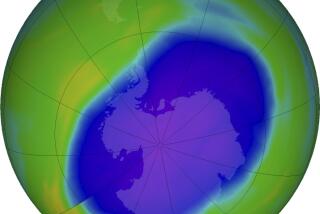Now, for a Worldwide Phase-Out of CFCs : Protection of Ozone Layer Must Be International Responsibility
- Share via
The startling discovery of a significant worldwide depletion of the Earth’s protective ozone layer demands an immediate response from world leaders.
As scientists attempted to explain the unanticipated Antarctic ozone “hole,” they questioned whether chemicals called chlorofluorocarbons, or CFCs, were indeed “the smoking gun.” Now, in the words of Dr. John Gille of the National Center for Atmospheric Research, the work of 100 scientists has produced “the corpse”--CFCs are the principal cause of ozone depletion.
The evidence uncovered by this project, sponsored by the National Aeronautics and Space Administration, requires action based on a combination of international cooperation and leadership by individual countries.
President Reagan and Secretary of State George P. Shultz should strongly urge the nations of the world to quickly ratify last September’s Montreal treaty to protect the ozone layer. Representatives of 31 nations signed the protocol, but only two countries--the United States and Mexico--have acted on it. The ratification of this treaty will lay the foundation for a worldwide effort to restore the ozone layer.
This process will most likely be accelerated by the Du Pont Co.’s announcement that it supports a phase-out of CFCs. That significant reversal by the largest manufacturer of CFCs, along with the new evidence of depleted ozone levels, are reasons why the United Nations Environment Program should set a date for reconvening the representatives of the 31 nations who signed the Montreal protocol. And those representatives should strengthen the protocol by requiring a worldwide phase-out of CFCs.
Although the Montreal treaty is an important step in protecting the ozone layer, it still allows the concentration of CFCs in the atmosphere to double from the levels of today. The ozone destruction detailed in the recent study is the result of CFCs emitted more than a decade ago. Additional decreases in ozone are an inevitable consequence of released CFCs that have not yet reached the stratosphere.
Had the findings that were released by NASA been known last September, the participants of the Montreal protocol conference would have had ample grounds to conclude that the text before them was far too weak. Nevertheless, the U.N. group should also urge nations to go ahead and ratify the existing protocol before they are reconvened to improve on the work that they completed in Montreal.
To achieve a rapid phase-out of CFCs, several steps should be taken in coming months:
--A substantial fee must be placed on CFCs, based on per-pound produced. Raising the price of CFCs will encourage their recycling and conservation, and speed up the development of substitutes. Safe substitutes are on industry’s horizon, but they will stay there as long as the price of CFCs remains low. A hefty CFC tax will prod industry to get alternatives out of the research-and-development departments and into the marketplace. Such a tax is consistent with Du Pont’s announcement, and represents an effective transitional policy to bring about a phase-out. The opportunity for industry is enormous when one considers the potential world-wide market for safe, inexpensive alternatives to harmful CFCs. In an era in which competitiveness is essential for economic survival, substitutes for CFCs present an excellent chance to compete--and succeed.
--National governments must act immediately to ban the non-essential uses of CFCs globally--for example, in aerosol cans, foam products like those that are used in food packaging, unnecessary servicing of automobile and other air conditioners, and many uses in the electronics industry, in which alternative products are currently available. Although the United States, Canada and Sweden banned the use of CFCs in aerosols more than a decade ago, other countries did not--and today aerosols represent 27% of worldwide CFC use. --When the seven major industrial nations meet at their economic summit in June, they should pledge to lead the international movement to phase out CFCs and begin rapid development of safe alternatives.
The countries that will be at the table at the Toronto summit meeting--Canada, England, France, Italy, Japan, the United States and West Germany--represent more than two-thirds of the world’s CFC use. Except for Canada and the United States, they are also the world’s heaviest users of CFC aerosols. If these leaders were to call for a phase-out of CFCs in their countries, the effect would be immediate and significant.
Given that the new research on ozone depletion has produced a “corpse,” it is now time to prevent further damage to our delicate atmosphere and to human health, the food chain and the natural environment. To do that requires aggressive action and creative cooperation by America and concerned nations worldwide.





